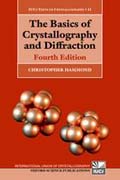
Covers the basics of crystallography and diffraction at an introductory level appropriate to the needs of students Makes difficult and abstruse topics 'crystal clear' Makes use of familiar and everyday examples in the explanations of symmetry and diffraction Describes X-ray and electron diffraction techniques and their applications in simple terms Emphasises the 'human element' in the development of the subject by way of historial and biographical notes New to this edition Revised throughout Includes new sections on Fourier analysis, Patterson maps, direct methods, charge flipping New chapter on the description of physical properties of crystals by tensors (Chapter 14) New Appendix on group theory in crystallography This book provides a clear and very broadly based introduction to crystallography, light, X-ray and electron diffraction - a knowledge which is essential to students in a wide range of scientific disciplines but which is otherwise generally covered in subject-specific and more mathematically detailed texts. The text is also designed to appeal to the more general reader since it shows, by historical and biographical references, how the subject has developed from the work and insights of successive generations of crystallographers and scientists. The book shows how an understanding of crystal structures, both inorganic and organic may be built up from simple ideas of atomic and molecular packing. Beginning with (two dimensional) examples of patterns and tilings, the concepts of lattices, symmetry point and space groups are developed. 'Penrose' tilings and quasiperiodic structures are also included. The reciprocal lattice and its importance in understanding the geometry of light, X-ray and electron diffraction patterns is explained in simple terms, leading to Fourier analysis in diffraction, crystal structure determination, image formation and the diffraction-limited resolution in these techniques. Practical X-ray and electron diffraction techniques and their applications are described. A recurring theme is the common principles: the techniques are not treated in isolation. The fourth edition has been revised throughout, and includes new sections on Fourier analysis, Patterson maps, direct methods, charge flipping, group theory in crystallography, and a new chapter on the description of physical properties of crystals by tensors (Chapter 14).
- ISBN: 978-0-19-873868-8
- Editorial: OXFORD UNIVERSITY PRESS.
- Encuadernacion: Rústica
- Páginas: 544
- Fecha Publicación: 01/05/2015
- Nº Volúmenes: 1
- Idioma:
